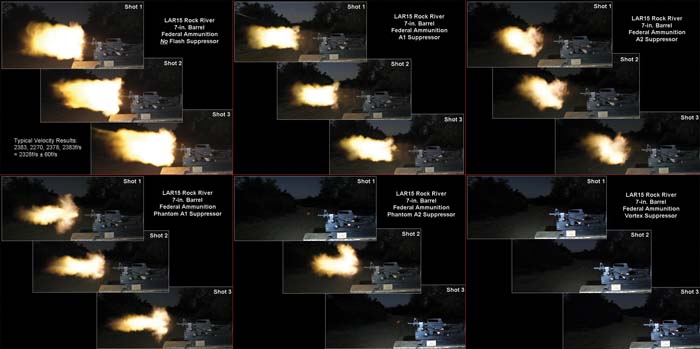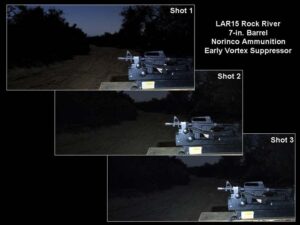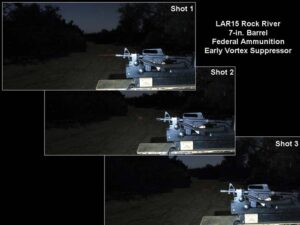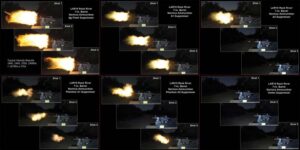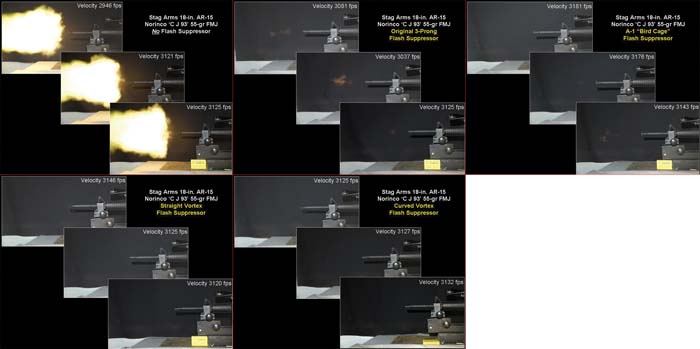
Background Information Muzzle flash occurs when partial combustion products from the propellant emerge from the muzzle of a firearm and ignite in the atmosphere. The combustible products consist of hydrogen and carbon monoxide from the deflagration of the fuel-rich nitrocellulose propellant along with partially consumed propellant particles. These gases and particles are expelled from the muzzle at high temperatures and pressure. Like any fuel, they must reach a satisfactory air-to-fuel ratio before they can be ignited. Flash suppressors interfere with this mixing process. Some additional factors dictating the presence or absence of muzzle flash and its character include barrel length, propellant type and chemical composition, the effectiveness of any flash retardants in the propellant, flame temperature, muzzle pressure, gas volume generated by the propellant, exhaust gas products and by-products and adequate mixing of these products with air. This mixing usually takes some time and distance. Consequently, photographs of muzzle flash from most small arms often show a non-luminous space between the fireball and the muzzle. Any small amount of flame present in or at the muzzle is likely due to the primer.
The size, character and color of muzzle flash can vary greatly ranging from virtually no visible light in front of the muzzle to a very large fireball. Color can vary from a dull to bright red, yellow-orange to yellow to nearly white with a slight lavender hue. The presence of muzzle flash is, of course, a serious problem in firearms intended for military and law enforcement.
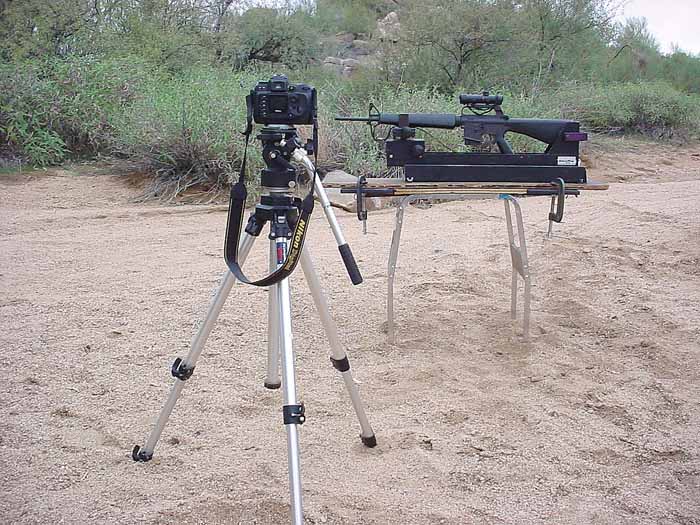
Over the last 50 years, manufacturers of military firearms such as the M14, AR-15 and other similar rifles have developed muzzle attachments that attempt to reduce or even obviate muzzle flash. Flash suppressants in the propellant are also an important constituent of nearly all military and law enforcement ammunition. Nearly 20 chemical additives have been listed in the literature as flash suppressants. The most common are potassium sulfate, potassium nitrate and potassium chloride in amounts up to about 2% but the presence of a flash suppressant is seldom if ever noted on canister propellants or, for that matter, on boxes of commercial ammunition.
Test-Documentation Procedures
The U.S. military under the U.S. Army Test and Evaluation Command has a Test Operations Procedure (TOP) for evaluating and measuring muzzle flash for a variety of small arms and larger weapons systems. TOP 3-2-045 (December 1983) contains a rather archaic procedure calling for the open shutter cumulative recording of twenty (20) shots with a 4×5 film camera positioned 4 to 5 feet out from the muzzle of the test firearm. A particular film speed and f-stop are also described. The testing is, of course, to be carried out in darkness. Strangely, no mention is made of the ammunition to be used or its composition or propensity to produce a muzzle flash with or without a flash suppressor attached to the firearm. This procedure not only seems awkward in the extreme but also self-defeating if one wants a realistic view of muzzle flash and some idea of its shot-to-shot consistency and reproducibility.
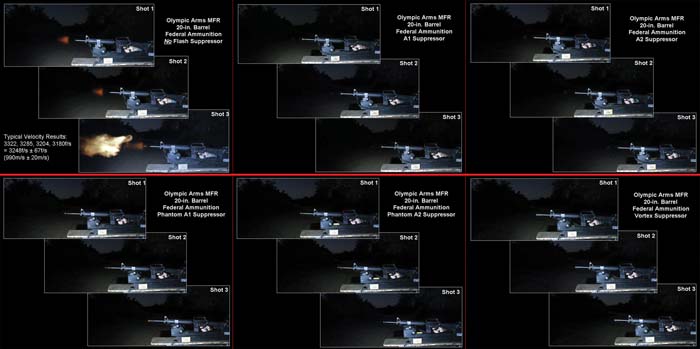
Contemporary digital cameras and a few chosen selections for f-stop and ISO settings comparable to those described here, along with a standoff distance on the order of 3 to 4 feet, provide the reader given to scientific testing a means for documenting and comparing muzzle flash.
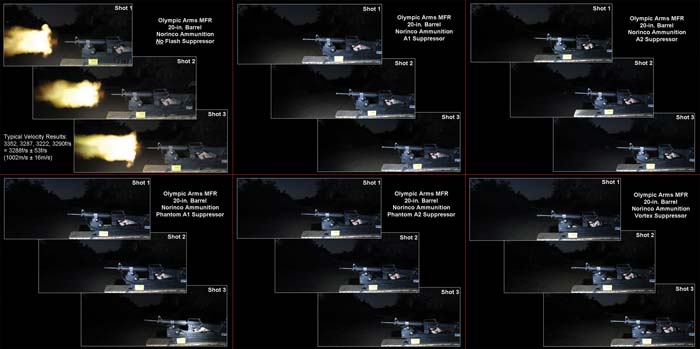
While not absolutely necessary, a mechanical gun rest of some sort makes a very desirable addition to any set up since it keeps the rifle at the same standoff distance from the camera and area of interest immediately in front of the muzzle centered in the camera’s view. An outdoor location free of ambient light except for a full moon was chosen for the majority of this work. Alternatively, a small camp light placed on the ground and behind the camera will provide sufficient working light and will not interfere with the photographic process.
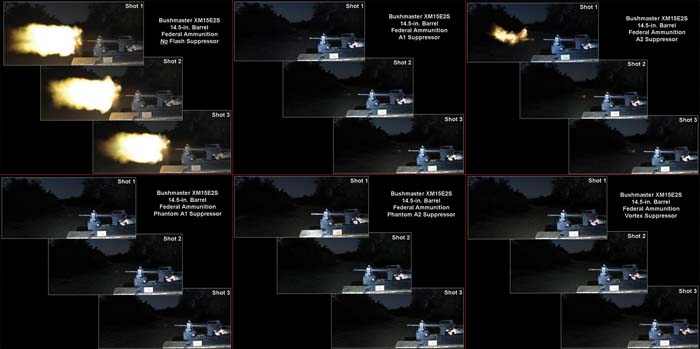
The authors used a Nikon D100 digital camera for the tests illustrated in this article but most any camera with a bulb setting or a built-in timer that will hold the shutter open for at least 4 to 5 seconds will accomplish the same end. If the bulb setting is to be used, a cable release will also be necessary and the cameraman will have to count off 4 or 5 seconds of exposure. The camera was positioned on a sturdy tripod so that it viewed the test rifle in profile from a distance of 4 feet with the test gun at the right edge of the frame. The remainder of the frame was reserved for any muzzle flash produced by the test shot.
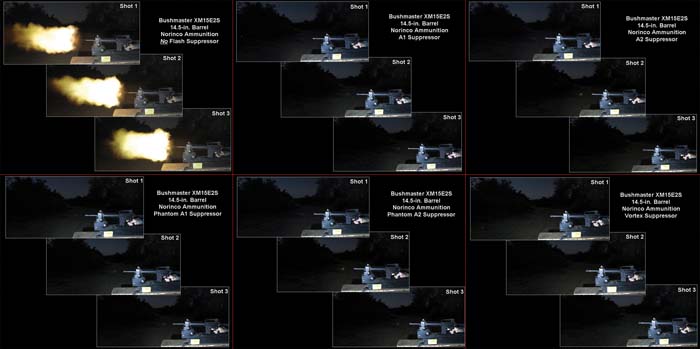
The exposure time was set at 4 seconds, with Auto White Balance, an ISO setting of 400 and an aperture of f/5.6. With a little practice, this time interval allows for a strobe to be flashed followed by the discharge of the test rifle. A hand-held strobe was held near the camera and at such a position so as to properly ‘burn-in’ the pre-discharge image of the rifle. The rifle was then fired and any muzzle flash is added to the previous image. The immediate playback on the rear screen of the digital camera also allowed for the confirmation of a suitable image. A minimum of three shots with each rifle/flash suppressor/ammunition combination was carried out as a test and documentation of reproducibility.
It is important to realize that in this method all visible light is captured and integrated into the final image. The duration of a muzzle flash is on the order of 0.01 to 0.03 seconds and even less in some cases whereas the average duration of an involuntary eye blink is about 0.1 to 0.4 seconds. This means that it is possible that an eye witness looking directly towards a nighttime gunshot will not see the muzzle flash even though other witnesses see it and subsequent testing shows that the gun-ammunition combination consistently produces a large, bright muzzle flash.
Firearms
The first series of tests employed the following firearms:
- Olympic Arms MFR – 20-in. barrel
- Bushmaster XM15E2S – 14.5-in. barrel
- LAR15 Rock River – 7-in. barrel
All three of these firearms possessed a 1 in 9-inch twist
Ammunition
Two sources of .223Rem./5.56mm ammunition loaded with 55-gr FMJ-BT bullets were used in these tests. These consisted of Norinco .223Rem ammunition (Chinese manufacture – no lot number – headstamps “C J 8”) and Federal brand XM193 ammunition bearing the Lake City headstamp “LC 07”.
Flash Suppressors
The flash suppressors tested were as follows:
- A1
- A2
- Phantom A1
- Phantom A2
- Vortex
- Early Vortex
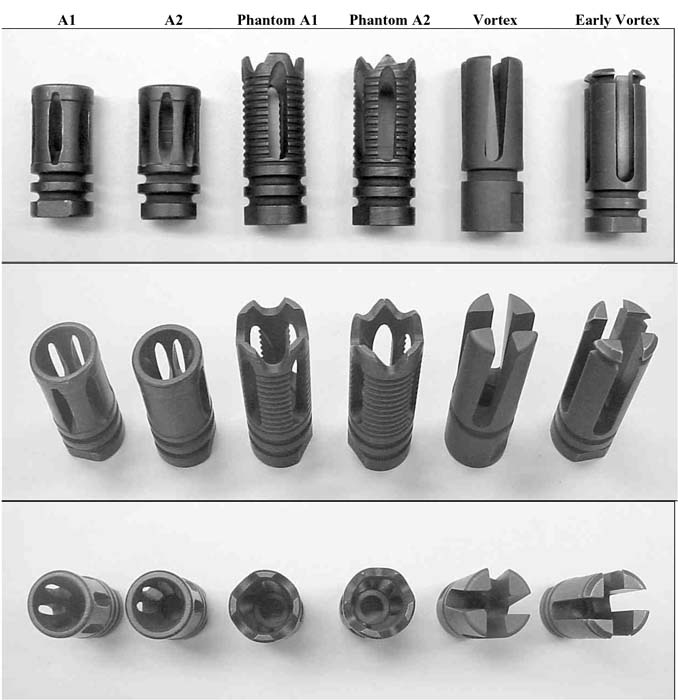
Test Considerations and Results
The essence of the Scientific Method in any testing protocol is to only change one variable at a time. The combined use of six flash suppressors and three barrel lengths allows a number of comparisons to be made. For example, one can isolate barrel length and ammunition (hold barrel length and ammunition constant) and study the effect of the six flash suppressors as well as the total absence of a flash suppressor. Alternatively, the effect of barrel length can be isolated by holding ammunition and flash suppressor constant. Finally, any difference due to the ammunition used in this study can be assessed by inter-comparing the appearance of any muzzle flash where the ammunition is the only variable.
Observations and Interim Summary – Phase 1
- 1. With only a few exceptions, muzzle flash, when present, was consistent and reproducible in appearance and size for each ammunition-barrel length-suppressor combination.
- 2. The muzzle flashes with both sources of ammunition were consistently yellow-orange in color. They invariably possessed a non-luminescent space between the muzzle and the actual fireball.
- 3. The Federal ammunition appears to contain a more effective flash suppressant than the Norinco ammunition (based on the results of the 20-inch rifle without a flash suppressor).
- 4. As expected, barrel length played an important role in the presence or absence of muzzle flash. The longer the barrel the less the muzzle flash, keeping the other variables of ammunition and flash suppressor constant.
- 5. Of the six flash suppressors employed in this study, the Vortex units far exceeded all other makes and models in their ability to suppress muzzle flash.
- 6. This technique or some simple modification of it will allow the reader to record and study muzzle flash. For those involved in ammunition selection, the inclusion of a scale at the gun position will allow quantitative measures of muzzle flash and criteria to be established for large quantity ammunition purchases. It also provides a means to study and compare the effectiveness of other existing or future flash suppressors.
Results and Observations According to Barrel Length
- 7. The Federal ammunition only produced a significant muzzle flash in 1 out of 3 shots with the 20-inch Olympic rifle without a flash suppressor. All of the flash suppressors were effective with this rifle and ammunition combination.
- 8. The Norinco ammunition produced a large muzzle flash with all 3 shots with the 20-inch Olympic rifle when this rifle lacked a flash suppressor. All of the flash suppressors were effective with this rifle and ammunition combination.
- 9. The Federal ammunition produced a large muzzle flash for all 3 shots with the 14.5-in. Bushmaster rifle without a flash suppressor. All of the flash suppressors were effective with this rifle and ammunition combination with the exception of the A2 suppressor that failed to totally suppress the muzzle flash for one of the three shots.
- 10. The Norinco ammunition produced a large muzzle flash with all 3 shots with this rifle when it lacked a flash suppressor. All of the flash suppressors were effective with this rifle and ammunition combination.
- 11. The Federal ammunition produced a large muzzle flash for all 3 shots with the 7-in. LAR15 rifle without a flash suppressor. The A1, A2 and Phantom A1 flash suppressors were only slightly effective with this rifle and ammunition combination. The Phantom A2 was partially successful in that it suppressed the flash in 2 out of 3 shots. Both Vortex suppressors were completely effective in suppressing muzzle flash with this rifle-ammunition combination.
- 12. The Norinco ammunition produced a large muzzle flash with all 3 shots with this rifle when it lacked a flash suppressor. The A1 and Phantom A1 were only partially successful in reducing muzzle flash. The A2 flash suppressor prevented 2 out of 3 flashes and the Phantom A2 only prevented 1 out of 3 flashes. Both Vortex flash suppressors were completely effective with this rifle and ammunition combination.
Phase 2 Tests
The ‘C J 93’ Norinco ammunition was used in combination with a Stag Arms 18-inch AR-15 to evaluate the flash suppressing capabilities of the 3-prong flash suppressor that came as original equipment on very early M16s. These results were compared to the current A1 “birdcage” flash suppressor and two types of Vortex suppressors. These tests were carried out in Forensic Science Service’s range using a black drop cloth behind the muzzle area of the rifle. A CED chronograph with infrared detectors was used to record the velocity values of each shot measured 10 feet downrange. The camera-to-muzzle distance for these tests was 3.5 feet and the aperture changed to f/6.3 due to the shorter standoff distance.
The two types of Vortex flash suppressors totally negated any muzzle flash whereas the 3-prong and A1 suppressors were reasonably effective, allowing only a small amount of flash to occur.
Summary
This work provides a method and some photographic parameters that will allow the reader to carry out and document muzzle flash tests. Some representative examples of muzzle flash, muzzle flash suppressors and muzzle flash suppression by these devices have been provided in the numerous figures contained in this article.
Special thanks are extended to David Fisher of Fisher Enterprises, Tempe, AZ for his assistance and the use of his Bushmaster XM15E2S.
| This article first appeared in Small Arms Review V12N12 (September 2009) |




